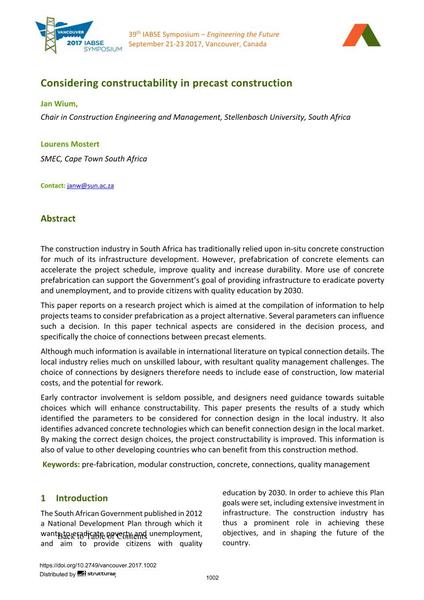Considering constructability in precast construction

|
|
|||||||||||
Bibliographic Details
| Author(s): |
Jan Wium
(Chair in Construction Engineering and Management, Stellenbosch University, South Africa)
Lourens Mostert (SMEC, Cape Town South Africa) |
||||
|---|---|---|---|---|---|
| Medium: | conference paper | ||||
| Language(s): | English | ||||
| Conference: | IABSE Symposium: Engineering the Future, Vancouver, Canada, 21-23 September 2017 | ||||
| Published in: | IABSE Symposium Vancouver 2017 | ||||
|
|||||
| Page(s): | 1002-1009 | ||||
| Total no. of pages: | 8 | ||||
| Year: | 2017 | ||||
| DOI: | 10.2749/vancouver.2017.1002 | ||||
| Abstract: |
The construction industry in South Africa has traditionally relied upon in‐situ concrete construction for much of its infrastructure development. However, prefabrication of concrete elements can accelerate the project schedule, improve quality and increase durability. More use of concrete prefabrication can support the Government’s goal of providing infrastructure to eradicate poverty and unemployment, and to provide citizens with quality education by 2030. This paper reports on a research project which is aimed at the compilation of information to help projects teams to consider prefabrication as a project alternative. Several parameters can influence such a decision. In this paper technical aspects are considered in the decision process, and specifically the choice of connections between precast elements. Although much information is available in international literature on typical connection details. The local industry relies much on unskilled labour, with resultant quality management challenges. The choice of connections by designers therefore needs to include ease of construction, low material costs, and the potential for rework. Early contractor involvement is seldom possible, and designers need guidance towards suitable choices which will enhance constructability. This paper presents the results of a study which identified the parameters to be considered for connection design in the local industry. It also identifies advanced concrete technologies which can benefit connection design in the local market. By making the correct design choices, the project constructability is improved. This information is also of value to other developing countries who can benefit from this construction method. |
||||
| Keywords: |
concrete connections quality management Modular Construction pre‐fabrication
|
||||
